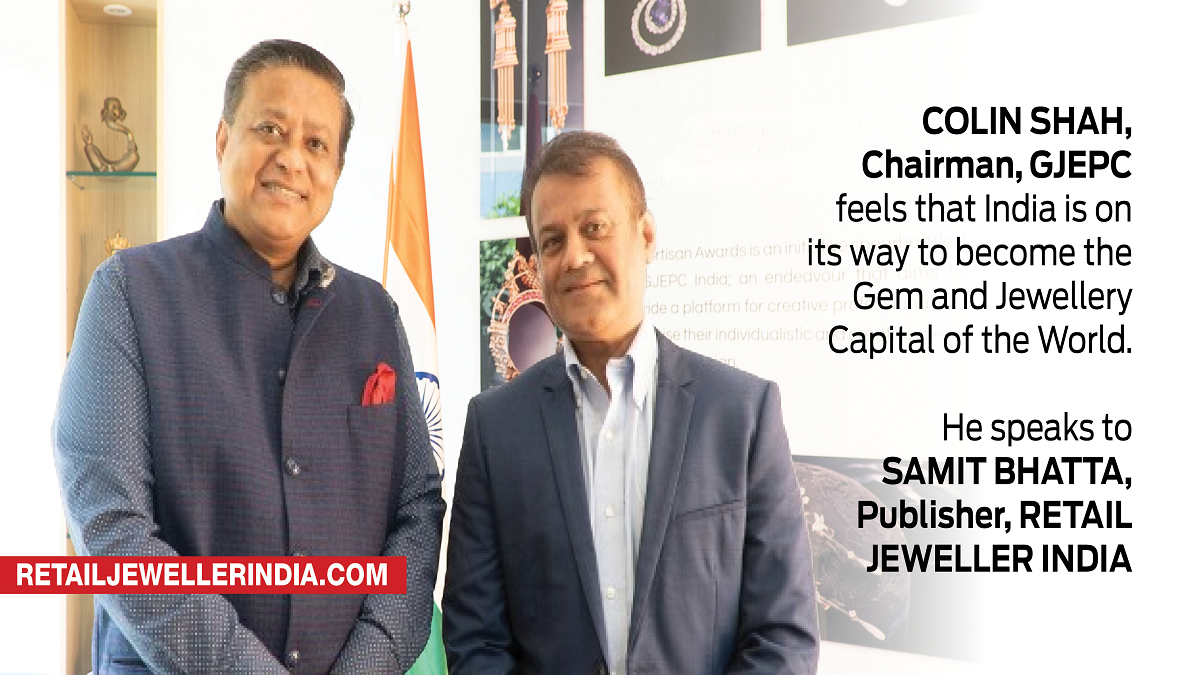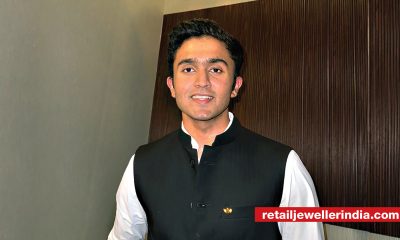RJ Market Watch
Retail Jeweller talks to Colin Shah, Chairman, GJEPC

Colin Shah on GJEPC’s achievements over the past two years of his tenure
When we started our tenure two years back, we were in the middle of the pandemic. And we still had the overhang of what happened when it came to Nirav Modi, Gitanjali, issue, when it came to the government, bankers, all the agencies, especially customs, and, I would say, our global image.
So, there was a lot to do. One of the first things we, at GJEPC, worked on was improving the image of the industry. That was the primary goal. And at the end of two years, I am satisfied that we achieved that on many fronts. Today, the image of the industry is much more positive, and all stakeholders are seen in a better light.
The first thing we did was to rebrand GJEPC, and give it version 2.0. We changed the logo, even though the earlier logo was pretty great. But we wanted to transform ourselves, and give a young, dynamic look to the Council. So that’s the first thing we undertook was to transform how we are perceived by the world. As I said earlier, when I started, we were in the middle of the COVID pandemic and the first lockdown. We tried to make the best of the situation. We had to deal with the crisis and reassure people in the industry that we would come out of the problem.
Industry players were worried about a number of things – they wondered whether people would continue to purchase jewellery. Plus, manufacturers had to keep their factories running retailers had to keep their stores open, and pay salaries to their workers and staff, even though there was hardly any footfall. They were burning their capital. Naturally, they were extremely worried about their inventory, and the future.
The Council stepped in and took a leadership role to get the industry together. We brought various entities together and debated about the future course of action. We discussed what we could do to protect the industry, protect the jobs of employees, and how we could ensure that the diamond dream continued. And I’m very proud to say that all stakeholders of the industry – manufacturers (small, medium, large), traders, and even the miners, came together, and we placed a rough moratorium on imports. That really helped the industry and as a result, as soon as things bounced back, there were no inventory losses.
Demand was at all-time high last Christmas. And the prices of diamonds went up and everyone could save their business and their employees’ jobs. In fact, everyone had one of the best years of their life in terms of business. It was a great achievement right at the start of my term.
We also created a portal called marketdiamonds.com, through which everyone can transact, and have their entire inventory online. We made Council membership mandatory for issuing KP certificates, with the support of the Commerce Ministry. How will that help? That will help in making sure that since we do a very strict KYC on all our members, there are no fly-by-night operators, at least in the rough diamond business. Besides, we collect the ad valorem on every import of rough, which helps in promoting diamonds. Besides, the Natural Diamond Council has done a phenomenal job of promoting natural diamonds, and in partnership with GJEPC, came out with all-new campaigns last year and this year to ensure the natural diamond dream remains relevant to millennials. The Council is playing a very active role on this front.
GST on diamonds, initiatives in gold
The trade had a big challenge in terms of input credit on GST. Consolidated, it was more than a few hundred crores. The trade had input credit that it could not avail of due to high charges of certification and exports being GST-free. We again got the trade together, and recommended to the government to make the GST on diamonds to 1.5 from 0.25, and this has really helped the trade to utilise the capital that was blocked and become revenue-neutral in the long run. That’s one of the other initiatives GJEPC took.
On the gold front, several things happened in the last two years. One of them is hallmarking, which became mandatory in our country. Hallmarking is mandatory in China and many other countries. Mandatory hallmarking has increased consumer confidence. As more and more parts of the country are making hallmarking mandatory, more hallmarking centres are opening up. Retailers are advertising and promoting it. As a result, consumer confidence is growing, especially among millennials. This has given a huge boost to daily wear jewellery, especially among the millennials.
Since mandatory hallmarking happened, and millennials have more confidence in gold jewellery, we decided to amplify it further and ensure that plain gold category remains relevant in the years to come. We did this “You are Gold” campaign with the World Gold Council. And I must say that the initial campaign, which has been put together by WGC’s Som (Somasundaram PR, Managing Director, India, World Gold Council) and his wonderful team, has been very, very effective. And as we sustain and build on this campaign in the next few years to come, I am sure that gold will continue to be a significant category, and not peter off as has happened in several developed markets across the world. And that’s another reason the Council has taken this very seriously since hallmarking happened.
We also revamped the gold monetization scheme. We have large reserves of gold lying in our country. An effective GMS will ensure that our dependence on imports will decrease and more gold will be released from vaults that can be reused in jewellery and could fulfil the wedding and investment demand in the country.
Natural Diamond Council
As a Council, we have also been working very closely with NDC — David Kelly, Richa Singh, and her entire team in India and the US. Many of our members are the largest sight holders, globally. And we do these monthly diamond review meetings — we get a lot of input from our diamantaires on what could be done to make the campaign more effective in the US, China, and India, which are the main markets for diamonds. And we are very happy to say that we work as partners with the NDC team in ensuring that the money spent is used effectively, and ensures that natural diamonds stay relevant for many, many years to come.
Vision for GJEPC
The Prime Minister’s vision has been to make India’s exports to $1 trillion. The gems & jewellery industry is an integral and important part of this export basket. We are at $40 billion. There’s no reason why we can’t reach $70 billion-$80 billion in the next three to five years. But to achieve this goal, it is very important that our category gets preferential
treatment, especially since we are signing FTAs with many countries. Our commerce ministry has taken this up on a war footing under the dynamic Piyush Goyal ji, and we are lucky that we were part of many of the discussions that happened with the UAE and Australia. CEPA got signed, the Australia FTA got signed, agreements with the UK and the EU are underway, and we are in negotiations with Canada and the US. These FTAs are really going to help our exporters get preferential access compared to China, Thailand, Italy, and Turkey, which are our main competitors, and will ensure that our exports keep on growing at a high double-digit rate.
Lab-Grown Diamonds
One of the sectors which has jumped in the past two years, with exports growing from $100 million to a couple of billion dollars this year, is the lab-grown diamond category. Now in the lab-grown diamond category, India has the opportunity today, as opposed to natural diamonds, to control the growing of the rough, cutting and polishing of the lab-grown diamonds, manufacturing jewellery out of it, and finally, exporting it to retailers globally, either as our own brand, or retail it domestically. So, this is one industry where India has the potential to become an end-to-end value creator and capturing the entire pipeline. Moreover, in our interactions with the Prime Minister himself and the commerce ministry and the finance ministry, the government has been very supportive in ensuring that this industry becomes a classic example of Atmanirbhar Bharat and Made in India.
We are in the process of finalizing a PLI scheme, there will be research and development for manufacturing the machine, and the seed, for which we are working very closely with IIT in India. We are also in the process of having a separate HSN code. A seat for a lab-grown board member was created in the Board of the Council, from now on, there will be a permanent seat for a lab-grown member. We have a lab-grown committee. We have more than 100 members now for lab-grown. It has also become an integral part of IIJS. Lab-grown has become an integrated part of GJEPC. At the same time, we are also ensuring that natural diamonds stay protected. Since the Council has taken a leadership role in both industries, we are going to ensure they both co-exist, they both grow, and they don’t eat into each other’s share.
New e-commerce policy
Many millennials have joined our industry. And one of the key businesses that every youngster in India wants to build today is a direct-to-consumer (D2C) business. For them to build that business, we need a robust e-commerce ecosystem. We have been working closely with the government on the e-commerce policy. The FM announced it in this year’s Budget and an eCommerce policy came out last month. As we go along, it’s only going to get better and stronger, and easier. And this will really help the next generation to build their D2C business, where they can be manufacturing or trading in jewellery in any place in the country, and could be shipping to nearly 200 countries around the world in a very cost-effective manner. They could be shipping through market places, they could be shipping directly to consumers. This e-commerce policy is going to transform our industry in the next few years.
New SEZ policy, DESH bill and mega CFC at SEEPZ, Mumbai
The first policy on SEZs was implemented in 1991 when Dr Manmohan Singh was the prime minister. And now we are in 2022. And in all these years, we have not really had a version 2.0 of the SEZ act. Now finally that has happened and the DESH Bill, as it is called, is now in Parliament right now, and it should become an Act in the next few months. This will completely transform the SEZs, as we know them. They will become the three “E”s — Economic Employment Enclaves.
The dream of the Prime Minister is to make sure that these 500 SEZs that we have in the country today, which are 500 out of 5000 in the world, become huge manufacturing centres, not only for MNCs and large Indian companies, but also for many MSMEs. This will really help as land will be available at a reasonable rate, electricity will be available at a reasonable rate, you can get labour at a very cost-effective rate, they are all very strategically located across the country. And you will be able to export and sell domestically through the same factory. So, this is really going to transform the SEZs, as we know them.
Further to the DESH bill, we were lucky to get Minister of Commerce and the Commerce Secretary and our Under Secretary and Joint Secretaries to our SEZ in Mumbai. And when they visited, they were very generous and appreciative of our idea to reboot the entire SEZ. We have a budget of close to Rs 200 crore to renovate the whole of SEEPZ, and that will really help us to make the infrastructure really world-class.
Besides, the Commerce Minister also approved a mega CFC. So, there is a budget of almost Rs 70 crore to build a mega CFC. A mega CFC will typically work where every large unit has access to the best technology in the world, but there are hundreds of units that don’t have access to high-end 3D printers or refining processes, or processes like CNC, platinum casting — there are higher-end processes that cost a lot. This mega CFC will make sure that technology and cutting-edge innovation is available to all of our MSMEs at a very cost-effective rate. This will ensure that the entire industry gets uplifted to make quality products which are globally accepted, designs which have cutting edge technology, and will also ensure that in this particular filed, India takes a leadership position compared to any other manufacturing centre in the world.
India and UAE partnership
India and UAE have always been very close strategic partners, our exports of $10 billion are routed through Dubai. Dubai is also a major hub for rough diamond imports, as many roughs from Antwerp, or Russia, or Africa come to India via Dubai. The CEPA agreement will ensure that this gets cemented further. The Council has opened an office abroad for the first time. I am proud to announce that the grand opening is expected to take place in September or October. IJEX, the centre we have built, will be like a special notified zone, or a major business centre where the exporters of our country can go to Dubai with their goods, keep the goods in the office there for two weeks, four weeks, or whatever, and can call customers there. So, without having the overhead of an office in Dubai, exporters can explore export opportunities in GCC region and Africa. The CEPA agreement will be instrumental in increasing the number of exporters who export to this region, and can also help us penetrate Africa in a big way, which is arguably the next new continent that is emerging as a huge market for gems and jewellery.
B2B shows
One of the prime roles of the Council is to increase exports out of India. For this, we need to do two things. The first is to increase the number of exporters out of India, and the second is to ensure that more clusters across the country get created for gems and jewellery. In order to further that goal, we held our first international show, which we hosted in Jaipur. It was only for international customers. We will definitely be continuing this edition, and like any show, in the years to come, it will only get stronger and better.
Secondly, now there are three IIJSs, so there is the Akshaya Tritiya IIJS, there’s Signature, and there’s Premier. There will be three IIJSs, which cover the broad spectrum of everything domestic manufacturers need to keep their plant running for 12 months. This year’s August IIJS had nearly 50,000 visitors and 2,000 exhibitors. IIJS has now become one of the biggest shows of the world.
And we are sure that with the exposure that the domestic manufacturer is getting in the shows, he will be encouraged to become an exporter. So, we have three IIJSs, we have an international show in Jaipur for the first time, and we will also be doing various buyer-seller meets in geographies around the world. We just completed the New York Diamond Week, which went off very successfully, as for the first time, we had gemstones in New York, we are going to be doing the Dubai edition, we are planning to do something in Australia. There’s going to be a flurry of activity internationally. And of course, IIJS will continue to be the best and biggest show in the country.
Design recognition and CSR
India has always been known as a low-cost manufacturing centre. And I would say that over the past two decades, we’ve been extremely successful in building brand India globally as a low-cost centre. But the future, like in any industry today, belongs to design and technology. So, furthering the design dream, the Council has become very aggressive in ensuring that design talent across the country is nurtured and encouraged. We incentivize entrepreneurs and exporters, because that’s where the value addition for the country is going to come from. In pursuit of these goals, we have ensured that the Artisan Awards become bigger and much more recognized globally.
We get more than 500 applicants from different countries around the world. And this is ensuring that design talent is encouraged. And we are seeing newer and newer designers entering the fray every year. And even the bar for creating these designs is getting higher. On the CSR front, the Council continues to stay active because that’s again one of our roles to make sure that we are doing enough for our craftsmen and artisans who come into this industry, and are building their future. One of the challenges we have faced is losing the next generation of these artisans.
The craft that has been passed down through generations is being lost. So, to make sure that artisans stay in this industry, we ensure that they get proper education, there is reskilling happening, we ensured during the COVID period that everyone got money in their pocket every month. So, through all our different activities, we ensure that our craftsmen stay protected. They have the income that they can earn in other industries, and design talent is also encouraged.
Vision for Indian gem and Jewellery industry
My vision for the Indian gem and jewellery industry is to become a $100 billion industry in the coming years. We should be known as the gems and jewellery capital of the world. Today, when we think of cheese, we think Switzerland, when we think of wine, we think France. So, India should be known for gems and jewellery. And we should be known not only for low cost, we should be known for the finest design, the finest technology, and the finest craftsmanship, and also for having entrepreneurs people can rely on, and trust. That’s my long-term dream for our country in general.
Courtesy: Retail Jeweller India News

 Personal Opinion2 weeks ago
Personal Opinion2 weeks agoBuy-back on gemstones to be on par with gold; A fear of return on the investment, more among high-end clients: Ankur Anand, Harsahaimal Shiamalal Jewellers

 Maverick Greenhorn1 month ago
Maverick Greenhorn1 month agoSegmenting retail approach to boost business performance

 Exclusive4 weeks ago
Exclusive4 weeks agoPrasad Jewellers’ Gold Bar Challenge fulfils multi-channel engagement goals, attracts young customers

 Daily News2 weeks ago
Daily News2 weeks agoTBZ – The Original launches its first store in Jaipur

























